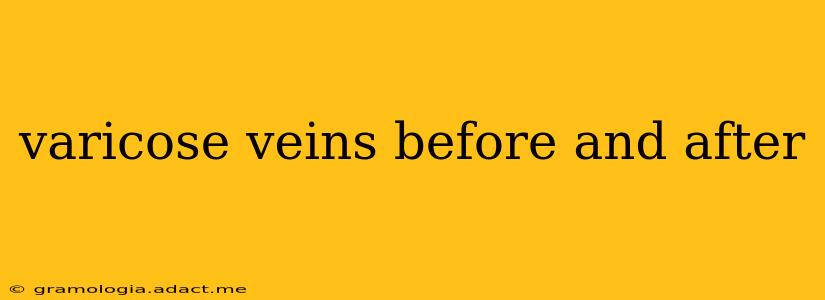Varicose veins, those unsightly, bulging, and often painful veins, are a common condition affecting millions. Understanding what varicose veins look like before and after treatment is crucial for making informed decisions about your health and appearance. This comprehensive guide explores the visual changes, treatment options, and what you can expect throughout the process.
What Do Varicose Veins Look Like Before Treatment?
Before treatment, varicose veins typically present as:
- Bulging, twisted veins: These veins are often larger and more visible than surrounding veins, appearing raised and contorted on the surface of the skin.
- Dark blue or purple in color: The discoloration is a result of the pooling blood within the damaged veins.
- Pain and discomfort: Many people experience aching, throbbing, swelling, heaviness, or cramping in the affected leg(s). This pain can worsen after prolonged standing or sitting.
- Itching and burning: Some individuals experience an itchy or burning sensation around the varicose veins.
- Skin discoloration: In severe cases, the skin around the veins may become discolored, darkened, or even develop sores.
The severity of varicose veins can vary greatly from person to person. Some may only have a few small, barely noticeable veins, while others may have extensive networks of large, bulging veins covering significant portions of their legs.
What Do Varicose Veins Look Like After Treatment?
The appearance of varicose veins after treatment depends heavily on the chosen treatment method and the individual's response. However, generally, you can expect:
- Reduced vein visibility: The treated veins will become significantly less visible or disappear altogether. They may appear smaller, flatter, or less discolored.
- Improved skin tone and texture: Any discoloration or skin changes associated with the varicose veins should improve.
- Relief from symptoms: Pain, aching, swelling, itching, and burning should be significantly reduced or eliminated.
Important Note: It's vital to understand that the "after" picture is not instantaneous. The full results of treatment may take several weeks or months to become fully apparent. Some slight discoloration or bruising may be present immediately after treatment, gradually fading over time.
What are the Different Treatment Options for Varicose Veins?
Several treatment options exist for varicose veins, ranging from minimally invasive procedures to surgical intervention. The best option depends on the severity of the condition and individual factors:
- Sclerotherapy: This involves injecting a solution into the affected vein, causing it to collapse and fade.
- Endovenous Laser Therapy (EVLT) or Radiofrequency Ablation (RFA): These minimally invasive procedures use heat to close off the varicose veins.
- Phlebectomy: This surgical procedure involves removing the varicose veins through small incisions.
- Surgery (vein stripping): A more invasive surgical approach, typically used for severe cases.
How Long Does it Take to See Results After Varicose Vein Treatment?
The timeframe for seeing results after varicose vein treatment varies depending on the method used:
- Sclerotherapy: You may notice some improvement immediately, but complete results can take several weeks or months as the treated veins gradually fade.
- EVLT/RFA: Results are often visible more quickly than sclerotherapy, but full results may still take several weeks or months.
- Phlebectomy: Immediate improvement is often seen, with continued improvement over several weeks as swelling subsides.
- Surgery: Similar to phlebectomy, you should see immediate results, with further improvement over time.
Will Varicose Veins Come Back After Treatment?
While treatment can significantly improve or eliminate varicose veins, there's always a possibility of recurrence, especially if underlying vein problems aren't addressed. Maintaining a healthy lifestyle, including regular exercise and weight management, can help reduce the risk of recurrence.
What is the Recovery Time After Varicose Vein Treatment?
Recovery time depends on the treatment method:
- Sclerotherapy: Minimal downtime, with most people able to return to normal activities immediately.
- EVLT/RFA: Minimal downtime, with most people able to return to normal activities within a few days.
- Phlebectomy: Minimal to moderate downtime, with a return to normal activities usually within a week or two.
- Surgery: More significant downtime, with a recovery period of several weeks or months.
Are Varicose Veins Dangerous?
While varicose veins are not typically life-threatening, they can cause discomfort and, in severe cases, lead to complications like skin ulcers or blood clots. It's crucial to consult a doctor if you experience any concerning symptoms.
This information is for general knowledge and should not be considered medical advice. Consult a healthcare professional for diagnosis and treatment of varicose veins.
